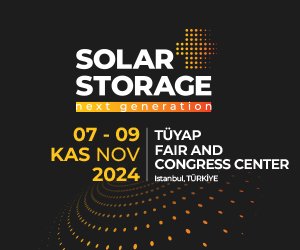Solar Panels
Amea Power, 50 mw solar power plant project in togo temperature energy project

Officially named Sheikh Mohamed Bin Zayed, after His Highness Sheikh Mohamed bin Zayed Al Nahyan, Crown Prince of Abu Dhabi, the PV plant has been delivered in record time, with just 18 months between the signing of the Power Purchase Agreement (PPA) and commencement of commercial operations.
Built by AMEA Togo Solar, a subsidiary of AMEA Power, the plant, located 267km from Togo’s capital, Lomé, has a planned production of nearly 90,255 MWh of power per year. This will supply power to approximately 158,333 Togolese households per year, with 9% of energy generation feeding into the local Blitta distribution network, enough to meet demand in the area.
The power plant will be operated for 25 years by AMEA Togo Solar, saving more than 1 million tonnes of CO2 emissions over the course of its life. The plant is instrumental in supporting Togo’s ambitious US$8 billion 2018 – 2022 National Development Plan (NDP), which aims to achieve universal access to electricity by 2030 and to increase the share of renewables in the energy mix to 50%.
Hussain Al Nowais, Chairman of AMEA Power, commented: “We are delighted to launch the Sheikh Mohamed Bin Zayed PV plant and extend our congratulations to all those involved. Togo was an obvious choice for AMEA Power’s first operational power plant in Africa, with it being an important trade hub in West Africa, along with the government’s progressive regulatory framework for renewable energy projects, which was key in ensuring the completion of the project in a fast, efficient, and responsible manner. This is an incredibly exciting time for AMEA Power, and we are on track to becoming one of the fastest-growing renewable energy IPPs, with several additional projects set to achieve financial close in 2021.”

His Excellency Faure Gnassingbé, President of Togo, and AMEA Power’s Chairman, Hussain Al Nowais, attended an inauguration ceremony today [22nd June 2021] at the power plant site. Other high-profile attendees included the Prime Minister of Togo, Victoire Tomegah Dogbé; Minister Delegate to the President of the Republic, in charge of Energy and Mines in Togo, Mila Aziable; Director of Compagnie Energie Electrique du Togo (CEET), Laré Santiégou; Senior Advisor to the President of Togo, Shegun Adjadi Bakari; President of the West African Development Bank, Serge Ekué; and the Deputy Director General of the Abu Dhabi Fund for Development (ADFD), Khalifa Al Qubaisi.
Mila Aziable, Minister Delegate to the President of the Republic, in charge of Energy and Mines in Togo, commented:“The development of the Sheikh Mohamed Bin Zayed PV plant is an excellent example of a successful Public-Private Partnership in Africa, with AMEA Power utilising Togo’s committed implementation unit and favourable investment climate to pre-fund a large-scale renewable energy project on balance sheet. We are delighted to have worked with a team of such highly-skilled professionals with demonstrated know-how in the energy sector.”
The project was supported with concessional loans from the West African Development Bank (BOAD) and the Abu Dhabi Fund for Development (ADFD). It was pre-funded on balance sheet, and then refinanced, a unique model for a large-scale IPP project in Africa. This is indicative of the level of project certainty created by the NDP’s regulatory framework, which provided AMEA Power with the necessary level of assurance and comfort to embark on the project’s execution well in advance of the financing being arranged.
Community impact
The construction of the power plant helped to create local employment opportunities, with 80% of plant workers hailing directly from Togo.
AMEA Power also invested directly in community initiatives in Blitta, which positively impacted more than 100,000 people, by constructing (and providing equipment for) one new clinic and three new school buildings; renovating four schools; providing school supplies for 1,400 students; and installing a water pump at a local primary school. AMEA Power will provide electrification via solar power to the schools and clinic.
Moreover, AMEA Power’s internship programme brought 36 engineering students from various technical institutions in Togo to the Sheikh Mohamed Bin Zayed PV plant, preparing them for employment by giving them the opportunity to apply their theoretical knowledge and develop their practical skills in renewable energies.
In response to COVID-19, AMEA Power distributed essential food and hygiene products to 8,500 families in nine countries across Africa, including 1,100 families in Togo. AMEA Power also distributed food and hygiene products to a further 8,000 families during Ramadan this year, which reached 1,100 families in Togo.
Solar Panels
Truck trailers with solar panels can save fuel

In a research partnership, Scania will develop a solar cell clad trailer to power a plug-in hybrid truck. Initial tests indicate possible fuel savings of 5–10 percent in Sweden and twice that amount in sun-rich southern Spain.
“Solar cells have previously been employed on boats and caravans but then only to power auxiliaries such as refrigerators and cookers and not the actual powertrain,” says Eric Falkgrim, Technology Leader in Vehicle Design at Scania R&D.
An 18-metre long solar cell clad trailer
The truck will be operated in daily transport assignments by the Swedish haulier Ernst Express, which also collaborated with Scania in trials of the world’s first electric road with overhead catenary lines. Ernst Express will operate an 18-metre long solar cell clad trailer with a total area along the sides and roof of 140 square metres. In total, the solar panels are expected in Sweden to annually generate 14,000 kWh.
The research project will also examine whether the trailer can feed electricity into the grid when the batteries are fully charged and the truck is parked, for example, over weekends.
Fuel savings up to 10 percent in Sweden
In a pre-study, operations in mid-Sweden were simulated reaching a potential fuel saving of 5–10 percent. In Sweden, there is enough sunlight from spring to autumn to generate energy and although the sun is weak except during summer, there are more hours of sunlight. During the rest of the year , there is insufficient sun in Sweden. By contrast, southern Spain has 80 percent more hours of sunlight.
The project is publicly funded the Swedish government’s innovation agency Vinnova and aside from Scania and Ernst Express also engages Midsummer that manufactures the solar panels, Uppsala University, which conducts advanced research on more efficient solar cells, and the Dalakraft energy company.
Solar Panels
FRV secures Green Finance for Sebastopol Solar Farm, NSW, Australia

Fotowatio Renewable Ventures (FRV), part of Abdul Latif Jameel Energy and a leading global developer of renewable energy projects, closed the financing agreement for the 90 MWac Sebastopol Solar Farm – its third major project in New South Wales.
The funding is entirely provided by ING in the form of a Green Finance compliant with the Loan Market Association (LMA) Green Loan Principles and the Green Projects requirements.
FRV signed a Power Purchase Agreement (PPA) for the project with Snowy Hydro in March 2020. In August FRV successfully completed the construction of the 69.75 MWac New South Wales Goonumbla Solar Farm, which also has a PPA awarded to FRV as part of the Snowy Hydro Renewable Energy Procurement Program in 2018.
Located 16 km south of Temora, approximately 440 km south-west of Sydney, New South Wales, the plant will connect to the national grid and generate enough power to supply over 40,000 Australian households and avoid the emission of approximately 77,600 tons of CO2 annually. This is the equivalent of removing some 27,700 cars from the roads each year.
Sebastopol Solar Farm will contribute to the economic development of the local area. FRV anticipate the creation of up to 150 jobs during the construction phase, and 2-3 operational staff for the life of the project. Site maintenance contracts will also be required and will be met by local businesses.
FRV has developed and secured PPA for a total of seven solar projects in Australia, operating and committed with an accumulated investment of over US$ 700 million since 2012: Royalla (20 MWac) in the Australian Capital Territory, Clare (100 MWac) and Lilyvale (100 MWac) in Queensland, Moree (56 MWac), Goonumbla (69.75 MWac) and Sebastopol (90 MWac) in New South Wales and Winton (85 MWac) in Victoria.
Carlo Frigerio, Managing Director of FRV in Australia, said: “This is our second financial close this year following Winton solar Farm in Victoria and I am delighted to see another FRV project starting construction in New South Wales after our successful delivery of the Goonumbla Solar Farm few months ago”. Mr Frigerio also added “We are also very glad to receive funding for the Project from ING in the form of a Green Finance confirming FRV’s commitment to support environmentally sustainable economic activity in the regions where we operate”.
Fady Jameel, Deputy President and Vice Chairman of Abdul Latif Jameel, said: “Through FRV, our flagship renewables business, Abdul Latif Jameel Energy furthers its commitment to delivering clean energy solutions in key global markets. We are grateful for our partnership with ING, securing a groundbreaking Green Finance for the Sebastopol Solar Farm. Together, we are encouraging responsible and sustainable infrastructure development in Australia’s renewable energy sector.”
Gordon Wymer, Chief Commercial Officer of Snowy Hydro, said “We are extremely pleased that FRV has progressed this project through the financial close milestone”. Mr. Wymer also added “Snowy Hydro continues to build its renewable energy portfolio, enabling new wind and solar projects to be built. This is providing much needed competition in the C&I market as well as a great outcome for our environment”.
Gido van Graas, Managing Director & Head of Energy of ING Australia, said: “Following the recent financing for the Winton and Goonumbla Solar Farms this is our third transaction with FRV in Australia and marks another milestone for our Energy team in Sydney who also acted as Green Structuring Advisor. By using a green loan to fund the construction of the Sebastopol Solar Farm is a clear testament of FRVs commitment to a sustainable future and contributes towards ING’s ambition to align our lending portfolio with the Paris Agreement goals”.
Solar Panels
The Spanish company ESAsolar develops ESAblock, the first system that protects photovoltaic trackers from the Wind

The Spanish engineering and manufacturing company of photovoltaic structures, Esasolar, has developed ESAblock, the first system in the world that protects solar trackers installed in the photovoltaic plants from the wind. This pioneering system guarantees the stability of the solar trackers and avoids the effect known as galloping or fluttering at any wind speed.
The Galloping or fluttering effect is an aeroelastic instability caused by the wind that is characterized for causing great amplitude oscillations in the tracker structures, producing a movement that can end with its collapse, literally making the structures and the photovoltaic panels that support it fly.
Esablock technology solves one of the great problems faced by large photovoltaic energy installations: the wind. The system guarantees their protection against it.
Wind gusts, even at normal and moderate speeds, can generate instabilities in photovoltaic structures and damage them, something that happens much more often than is desirable and that has a very negative influence on the performance and profitability of photovoltaic plants, which, in addition to the reparation costs, are forced to stop, either partially or completely their activity, which has a negative effect on the production of electricity and its profit.
As Antonio Jesús Martín Nuñez, technical director of Esasolar explains, “so far, with the protection systems available on the market, they only begin to work when the wind exceeds the working speed of the tracker, which, generally, is usually lower than 75 Km / h. It often happens that, at lower wind speeds, the catastrophic effects of Galloping or Flutter can occur, even with the traditional protection system activated”.
As a catastrophic example of this effect, the technical director of Esasolar mentions the Tacoma bridge case in the US, which collapsed in 1940 because moderate-speed winds produced an aerolastic flap that coincided with the natural frequency of the bridge, causing its collapse.
According to the general director of Esasolar, José Antonio Maldonado, the great contribution of this system is that it combines the versatility and efficiency of solar trackers (structures that move to orientate themselves towards the sun) with the safety of fixed structures, which always remain in the same place and position.
“Our technology – explains Maldonado – allows the structure to move in order to follow the sun, but once it has reached its new position it stops and it blocks itself as if it were a fixed structure, which is not affected by the wind; This means that it is always protected and safe, and makes the wind just one more environmental factor, but not a risk ”.
Innovation: a key element for the Spanish photovoltaic sector development
The development of ESAblock technology, which has been developed in the company’s research center in La Roda de Andalucía (Sevilla), is an example of the company’s innovation philosophy that characterizes Esasolar.
As Maldonado highlights, Spanish companies have an extraordinary opportunity to lead the solar world energy market by contributing with their innovation and knowledge capacity along with their extensive experience. “It is not only about benefiting of the advantages that photovoltaic energy can have in our country by the installation of photovoltaic facilities, but also, it is about using our knowledge to lead the world market and to offer our technologies, products and services to build photovoltaic installations all over the world”.
Esasolar is a Spanish company, an international leader in the designing, manufacturing and supply of photovoltaic solar structures and trackers. With offices in Madrid, Sevilla and La Roda de Andalucía (Sevilla). It also has a research center in the latter location where solutions are developed that will be supplied to clients all around the world.
Esasolar’s added value is present on its strong vocation for innovation, research and development, as well as its ability to adapt and customize its proposed solutions in all projects to the needs of each client.
-

 Solar Panels7 years ago
Solar Panels7 years agoAre Tesla solar roof tiles worth it?
-

 Genel7 years ago
Genel7 years agoMaldives luxury resort is powered entirely by solar panels
-

 Control Systems Et Software7 years ago
Control Systems Et Software7 years agoHOMER responds to the rapidly growing solar+storage market with Grid software
-

 Solar Technologies6 years ago
Solar Technologies6 years agoGOODWE PARTNERSHIP WITH GE
-

 Solar Technologies5 years ago
Solar Technologies5 years agoSolar panel covered Autobahn can break speed record for Germany’s energy transition
-

 Operation and Maintenance7 years ago
Operation and Maintenance7 years ago1000-Acre Sunflower Solar Farm to be Built for Entergy Mississippi
-

 Events6 years ago
Events6 years agoGREENoneTEC revolutionizes solar heating with Sunpad
-

 Large -Scale Solar Panels7 years ago
Large -Scale Solar Panels7 years agoABB to construct solar power expansion in Dubai








